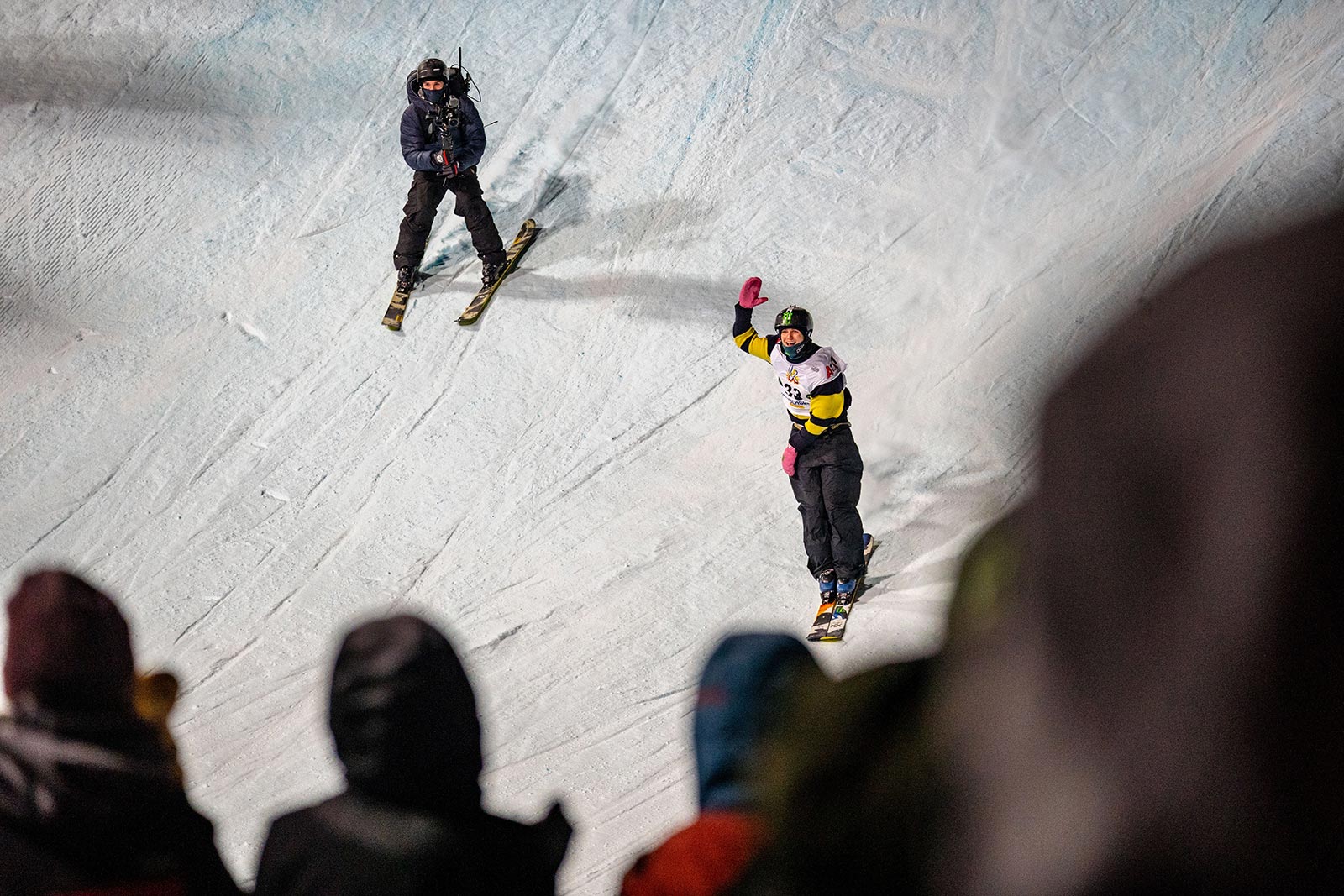
Event News
Big Air Season Starts with a Bang in Kreischberg
Last week the news was dominated by reports from Washington, D.C., where an unruly mob of deluded fanatics stormed the Capitol in support of the world’s sorest loser. Meanwhile across the Atlantic, some of the world’s best freeskiers were busy storming the slopes of Kreischberg, Austria for the first World Cup Big Air event of 2021, where thankfully, no sore losers were in sight.
Athletes and crew arrived in Kreischberg on Monday, where the first order of business was Covid-19 testing, with mandatory PCR tests for athletes and rapid tests for media. “In order to get any kind of accreditation, you had to show that you were negative,” said Noah Wallace, our man on the ground.
Practice kicked off on Tuesday on the jump at the Freestyle Training Center. Conveniently situated at the base of the resort, the Big Air jump is built with underlying earthworks, and is equipped with lights for nighttime events. Already a favorite stomping ground for athletes in the region and beyond, many competitors had been skiing here in the weeks leading up to the event, getting used to the jump and setting the stage for a big show.
“Right away you could tell it was going to be a big contest,” said Wallace. “People were throwing their biggest tricks after only a few hits.”
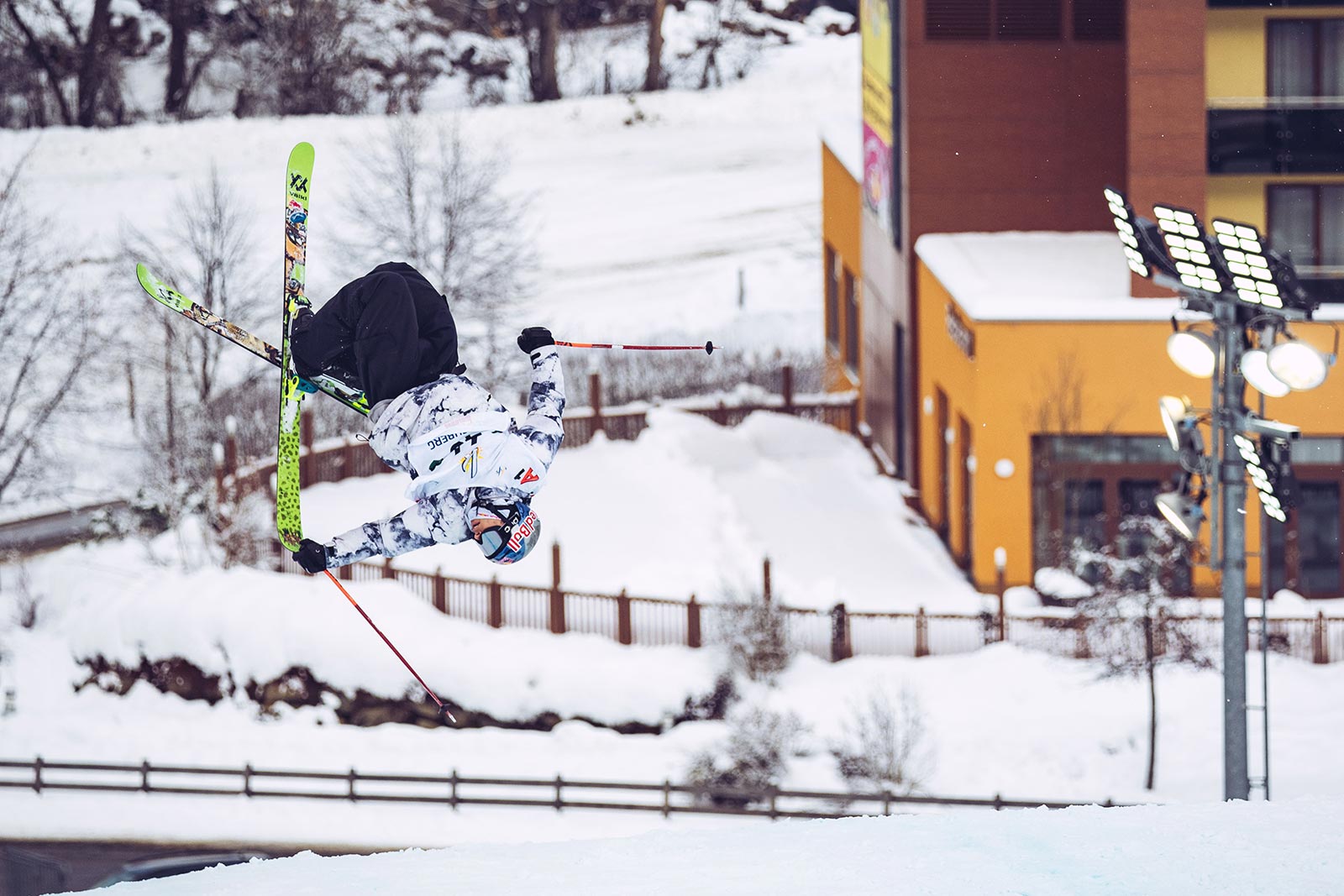
Nick Goepper works out the kinks during practice.
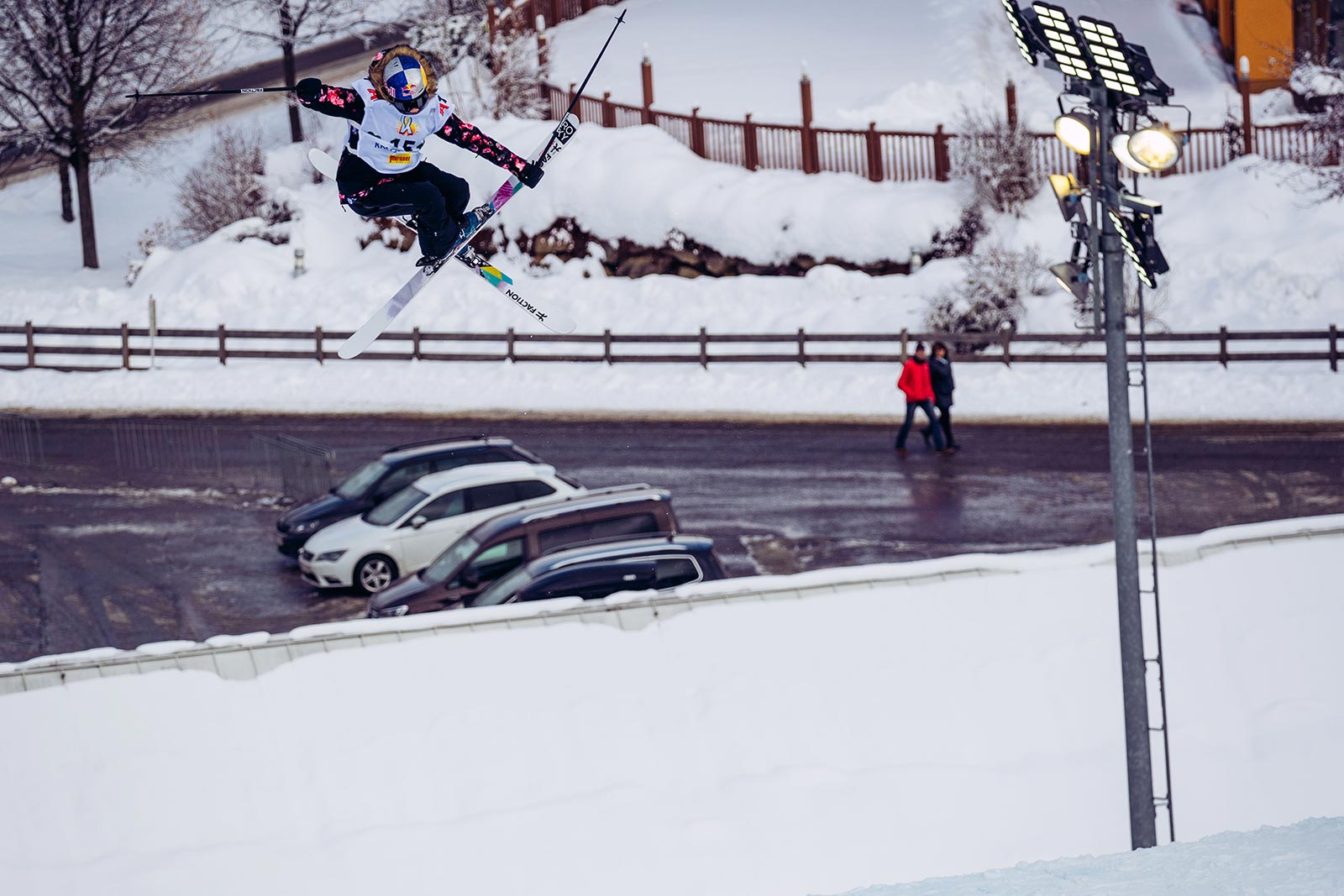
Kelly Sildaru tweaking mute.
Women’s Qualis: Ledeux takes the lead
Perfect conditions and sunny skies set the scene for the women’s qualification round on the morning of Thursday, January 7, with 25 competitors from 15 nations vying for six spots in the final. With her polished double cork 1260 mute and switch 1080 double japan, French ace Tess Ledeux clinched the top qualifying spot. She was joined in the finals by the Swiss duo of Giulia Tanno and Mathilde Gremaud, Norway’s Johanne Killi, Estonian star Kelly Sildaru, and Silvia Bertagna of Italy.
Narrowly missing the cut were Austria’s Lara Wolf, who put down a clean double cork 1260 but couldn’t capitalize with a strong second trick, and Swiss heavyweight Sarah Hoefflin.
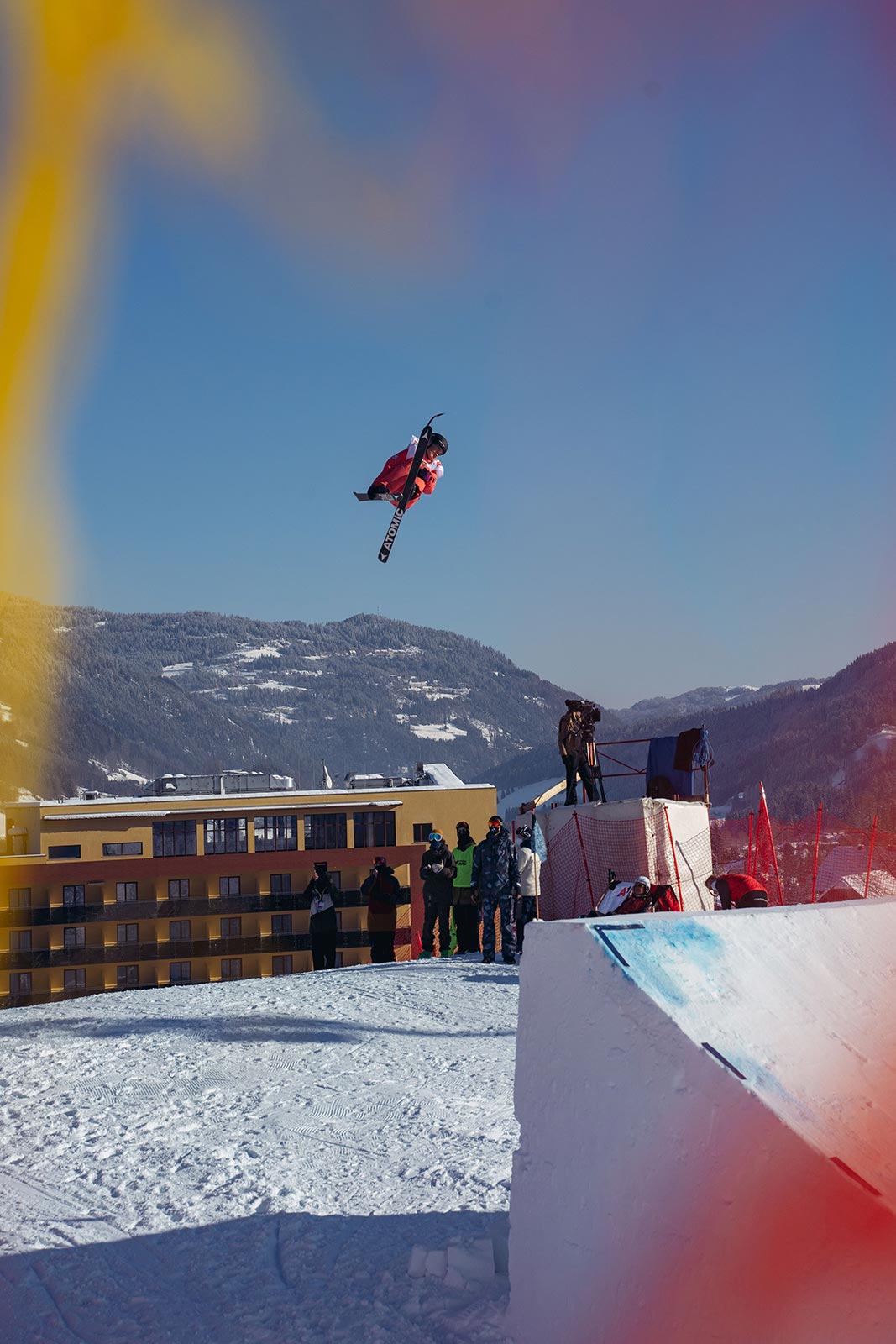
Lara Wolf landed her double 12 but barely missed the finals.
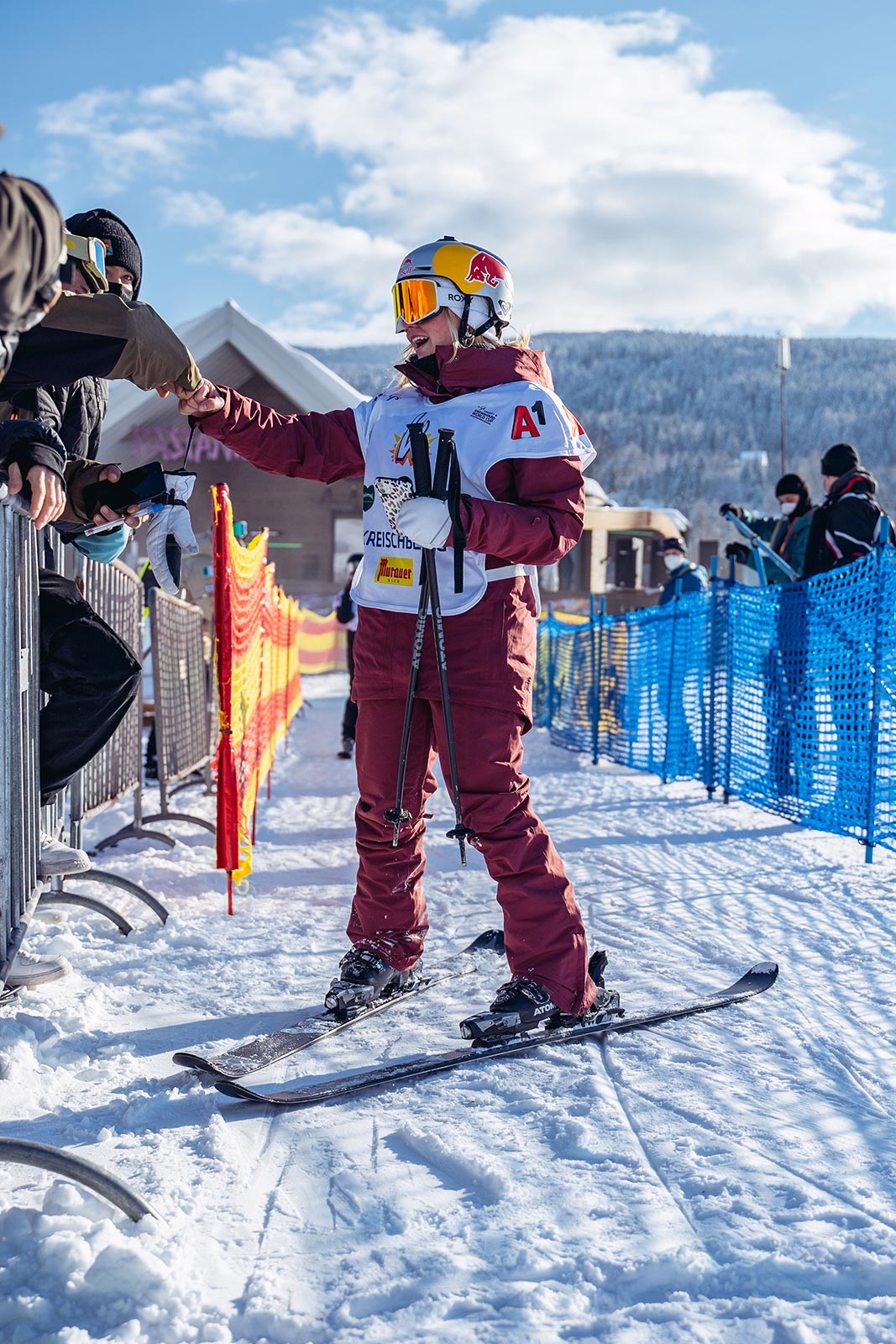
Top qualifier Tess Ledeux.
Men’s Qualis: Adelisse & Ruud on top
The men’s qualifiers followed on Friday morning: 31 competitors divided into two heats, with the top five in each heat advancing to the finals. With overcast skies and flat-light conditions, expectations weren’t high at first. But the clouds broke just as training began, setting up a qualification of rare form.
In the first heat, French big-air monster Antoine Adelisse secured the top spot with his favorite one-two punch: triple cork 1620 mute and switch pre-nose triple cork 1440. He was pursued by energetic Czech up-and-comer Matej Svancer, Norway’s Christian Nummedal and Swiss powerhouse Andri Ragettli. The big upset of the day was delivered by Canadian young-gun Edouard Therriault, who earned his first appearance in a World Cup final while edging out none other than Henrik Harlaut for the last qualifying spot in the heat.
Others missing the cut included Oscar Wester, Nick Goepper, Jesper Tjäder, local favorite Lukas Müllauer, and Thibault Magnin, who still managed to put down one of the craziest tricks of the day: a switch double cork 1260-style rotation that he pretzeled back to land switch.
View this post on Instagram
In Heat 2, Norway’s Birk Ruud locked in the lead position with his unique ability to spin 1800 degrees forward and switch. Kim Gubser and Colin Wili of Switzerland followed, with Sweden’s Oliwer Magnusson and the USA’s Alex Hall rounding out the top five. Norwegians Sebastian Scherve and Ulrik Samnøy missed the cut by a few points, trailed by Fabian Bösch and Teal Harle. The day’s craziest moment came from Evan McEachran, who pulled his ski off during a triple cork 1440 mute and still somehow managed to stomp cleanly on one foot.
Women’s Finals
The finals took place under the lights on Friday evening. Although Covid restrictions kept a crowd from forming, spectators were able to watch from their vehicles in the nearby parking lot, honking their horns and hollering for the big tricks. And there were plenty of those to go around.
Tess Ledeux stomped her double cork 12 mute clean in the first round to gain an early lead. Giulia Tanno moved into second place with a double cork 1080 safety, while Kelly Sildaru put down a switch rightside 1080 mute. Silvia Bertagna — at age 34 the senior skier in the field — landed a switch 900 mute, while Mathilde Gremaud crashed on her attempt at a carve double cork 12. Johanne Killi wasn’t able to start in the finals, and for some reason wasn’t replaced with an alternate, leaving only five rather than six women to vie for the podium. If this is standard practice at FIS events, then that’s quite the shame. There were 19 other women in attendance who all would have loved to occupy that finals spot.
In the second round, Ledeux came up a bit short on her switch 1080, but still squeaked out a clean landing, good enough to maintain her lead. In hot pursuit, Tanno landed her own switch 1080 with a tail grab. Kelly Sildaru mirrored her rightside switch 10 with the same trick to the left side. These back-to-back 10s have been her bread and butter for years, but they’re starting to look a bit worn out as double corks increasingly define the competition. Gremaud crashed again on her carve double 12, trying just a bit too hard to channel the spirit of Kai Mahler, while Bertagna grabbed mute too hard and pulled off her ski on a switch 10 attempt.
In the third round, Bertagna opted for a cork 900 blunt, deciding not to try the double cork 1080 that she recently learned. Kelly Sildaru looked to improve her switch right 1080, but only spun to 900. She didn’t look very happy, even as she coasted into third place. Is it finally time for the Estonian wunderkind to enter the doubles era? With two crashes, Gremaud didn’t take her third hit, and the evening came down to a showdown between Tanno and Ledeux. Tanno improved the landing on her double cork 1080 safety and slipped ahead of Ledeux by a single point in the standings. Needing to improve her switch 10, Ledeux took a bit too much speed and crashed on the landing, narrowly missing out on a victory that had looked all but certain for her.
“When I dropped in I knew I was on the podium, so I was just trying to land the best dub 10 I’ve ever done,” said Tanno. “I thought I can’t overtake Tess, and I was surprised to see the score. I cried some happy tears, to be honest.”
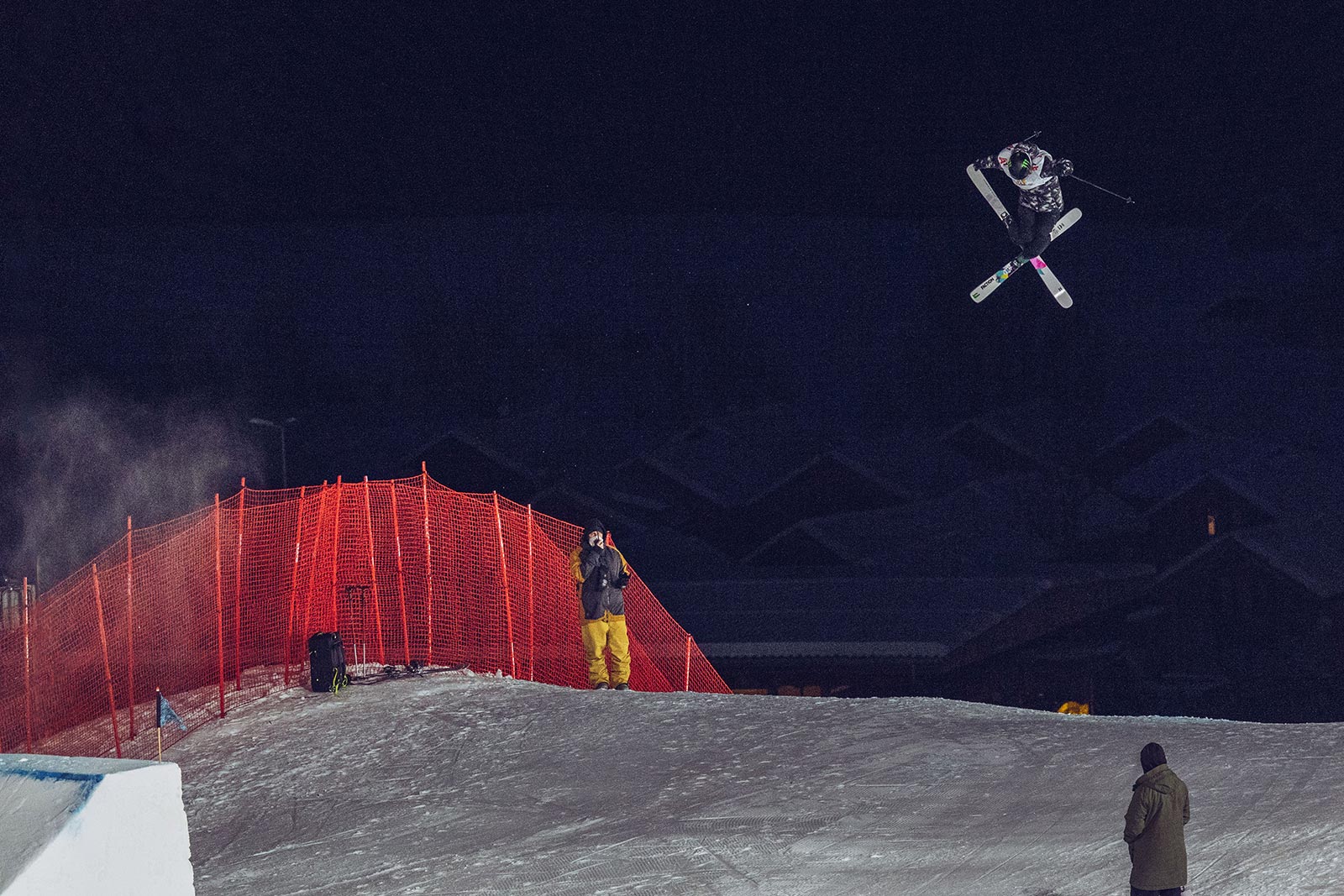
Giulia Tanno´s switch 10 tail was clean enough to give her edge over Tess Ledeux.
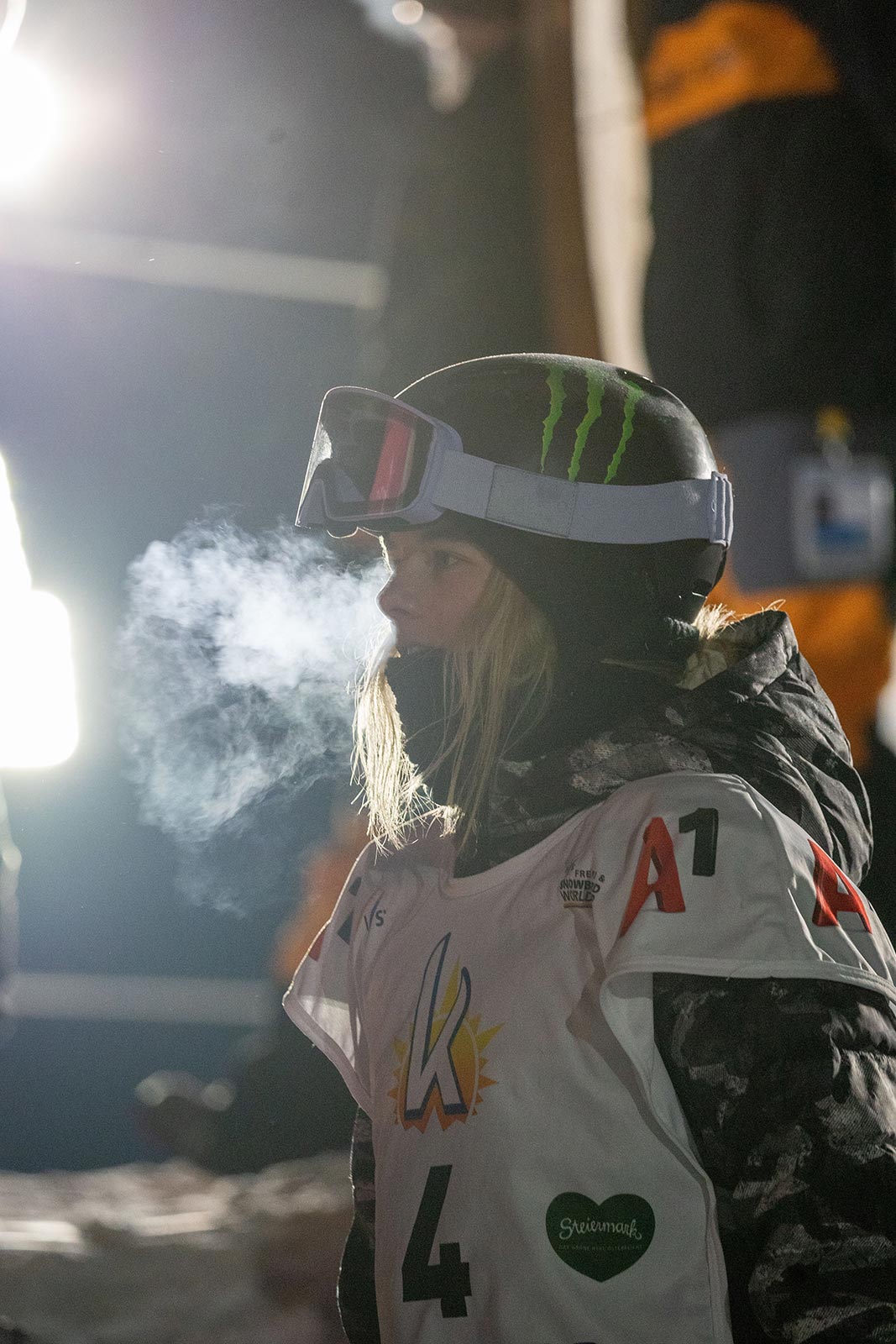
Giulia in the zone.
Men’s Finals
The men came out swinging, with an unbelievable nine out of ten tricks in the first round scoring in the 90s. There’s no doubt about it: this was an absolute throwdown. In the past, World Cups have struggled to reach the highest levels of competition. This event looked like an X Games final, straight from the get-go.
Eduard Therriault: triple cork 16 mute. Alex Hall: Double cork 16 Buick (if that’s really what we're calling this grab now). Andri Ragettli: double cork 16 double tail. Oliwer Magnusson: double cork 1800 tail. Christian Nummedal: dub 16 tail to japan (missing the tail). Colin Wili: switch triple cork 1440 octograb (making James Woods proud). Matej Svancer: switch triple cork 1440 safety (looking like a spitting image of E-Dollo). Kim Gubser: switch triple 14 high Phil grab. Antoine Adelisse: triple cork 16 mute. And last but not least, Birk Ruud: switch double 1800 blunt for a high score of 96.00 and the lead. And that, friends, was only the first round.
In Round 2 the 1800s kept coming: switch dub misty 18 from Ragettli, switch dub cork 1800s from Magnusson and Nummedal, and a forward dub 1800 from Birk Ruud. If last year was about landing 1620s, this year is all about the 18s. Meanwhile Gubser and Wili pounded out forward triple 16s, Svancer laced up a beautiful nosebutter double cork 16 japan, Adelisse stomped his signature prenose switch triple 14, and Alex Hall managed to cleanly kick his ski off midair in a switch dub 16 for a not-so-soft landing. At the conclusion of the second round, Ruud had advanced his lead with switch and forward 18s, trailed by Adelisse in second and Magnusson — who’d capped blunt cleanly on his switch 18 — in third.
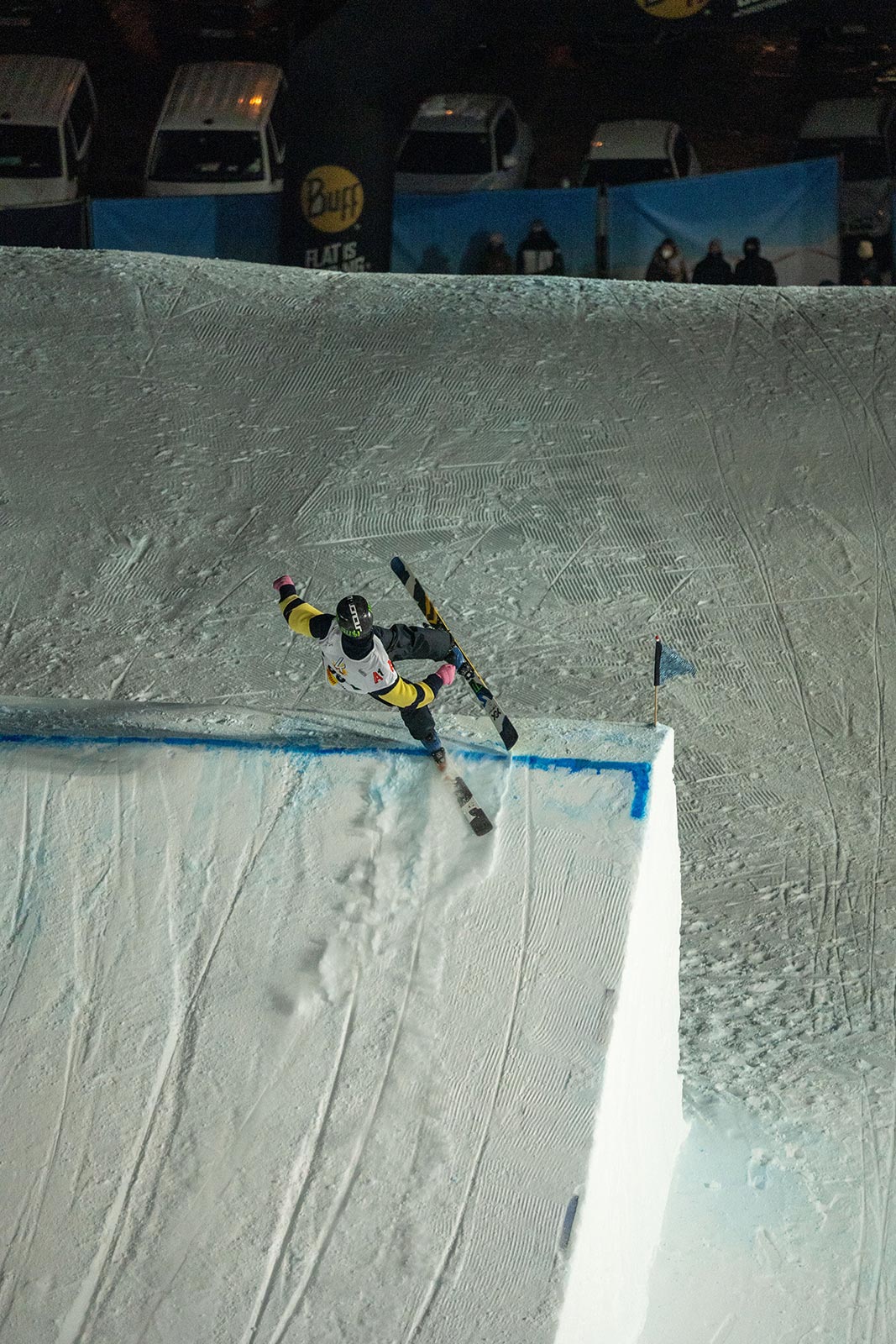
Want to spin 1800 degrees? Best be setting hard off the lip.
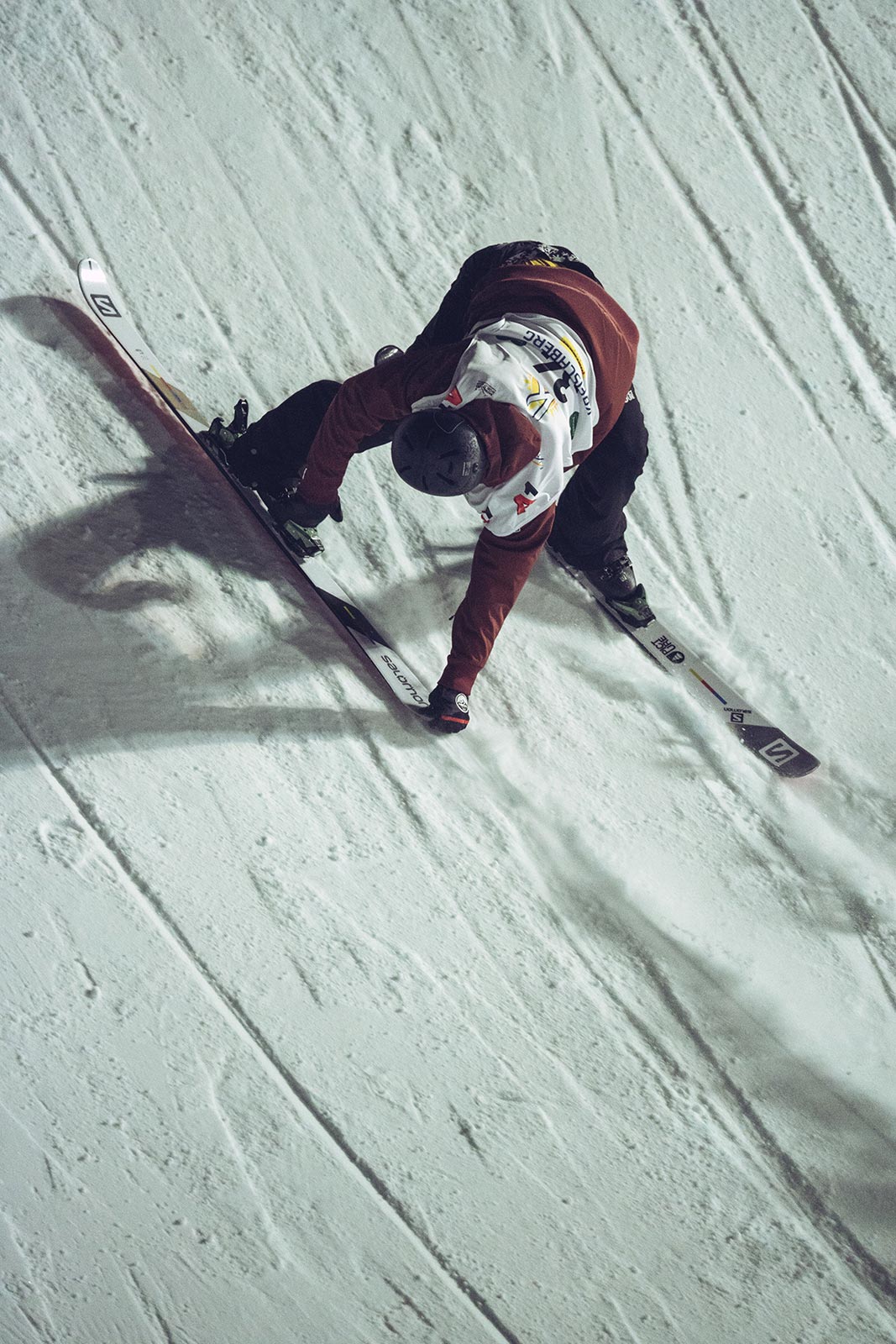
Antoine Adelisse has turned the prenose grab from a stunt trick into a big air goldmine.
Round 3: this one for all of the marbles. A-Hall landed a switch dub 14 to make up for his crash the previous round, while Therriault backed off his ambitions for a switch double bio 18, taking it to 1620 instead. Christian Nummedal looked to get a clean grab on his switch dub 18 but came up short on the rotation, while Svancer joined the 1800 club with a jaw-dropping nosebutter double 1800. Gubser improved the score on his triple 16 mute, while Wili tried to slip a second grab into his triple. Ragettli tried to improve his double cork 16 double tail and held the grab almost to the landing, but came up a bit short on the rotation and crashed.
Magnusson unleashed the night’s biggest spin, an attempted double cork 1980 blunt—almost landing but under-rotating by a hair. The last rider with a chance to unseat Ruud from the top spot, Antoine Adelisse tried to pack a three-grab combo (mute, safety, tail) into his triple 16, but lost control of his axis and crashed. This left Birk Ruud with a victory lap, which he put to good use by landing what might be called a cork zero or flat zero. I’ll be honest: I’ve watched this trick on replay about thirty times, and still don’t know what the hell is going on.
View this post on Instagram
A few takeaways
That, ladies and gentleman, was a Big Air final to be remembered. I can’t remember the last time I’ve seen so many scores in the 90s in a single contest. There are a few takeaways here.
1) The pandemic has not slowed down the pace of progression at all. If anything, these guys and gals are hungrier and stronger than ever. Nearly every rider had a new trick to bring to the table in Kreischberg.
2) If anyone still doubts that World Cups can hold water, you can put those doubts to rest. I say this with an unblemished record of FIS-hating behind me. This was the highest level World Cup Big Air yet, without a doubt.
3) 1800s are the new 1620s. Get used to it.
A Wacky World Cup Season
Like everything else this year, the World Cup circuit has faced its share of disruption. The first two Big Air events of the season, planned at Beijing’s permanent Big Air facility in November and Copper Mountain, Colorado in December, were both cancelled.
After Kreischberg, there’s now a long break in the schedule until the World Championships at the end of February, which have reportedly been relocated to Calgary from China. There’s also rumored to be a second World Cup event brewing in Calgary around the same time to make up for other cancelled events. After all, it’s an Olympic qualifying season, and there are precious few contests still around at which athletes can rack up points.
Replays
If there’s anything to be criticized, it’s the fact that World Cups still can’t manage to offer a free livestream for their events—or in this case, even get the top tricks on YouTube. This seems to be a no-brainer for organizers and sponsors alike, but sadly this event and others are still constrained by restrictive broadcasting contracts that don't allow anyone to post anything online.
If you’re in Austria (or know how to use a VPN client) you can watch a full replay in the ORF Mediathek. Or you can pay for a subscription to watch the contest on Eurosport.
Update: Full replay available via NRK
Full Results: Kreischberg 2021 World Cup Big Air
Instagram Roundup
View this post on Instagram
View this post on Instagram
View this post on Instagram
View this post on Instagram
View this post on Instagram
View this post on Instagram
View this post on Instagram
View this post on Instagram
View this post on Instagram
View this post on Instagram